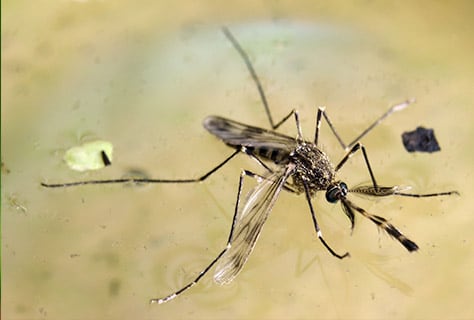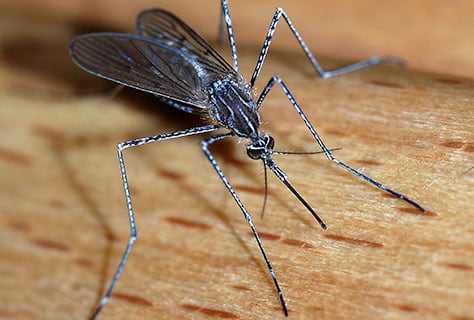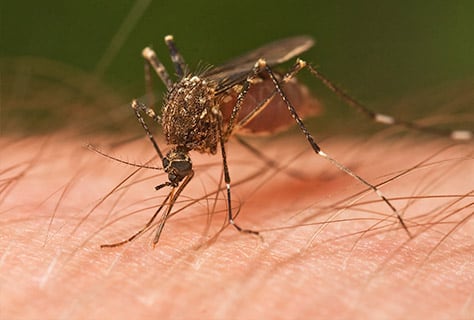Types of Mosquitoes
Find nearby providers to get rid of mosquitoes today
Right now, scientists have classified over 3,000 types of mosquitoes with different subfamilies and genera being discovered every year. Though some species aren’t dangerous to man, most of them are at least considered pests because the female needs a blood meal before she lays her eggs. This means that a swarm of even harmless mosquitoes can be unbearable.
But the real problem is that in the act of biting, certain species of mosquitoes can transmit diseases, many of them very dangerous or even fatal. Entire ancient civilizations in the Mediterranean have been wiped out because of mosquitoes.
There are two mosquito subfamilies. They are anophelinae and culicinae. Among these subfamilies are many genera. They include:
Aedes Mosquitoes
The Aedes aegypti mosquito is a carrier of both yellow fever and dengue fever. These diseases resemble each other. However, yellow fever is sometimes fatal to its victims, but dengue fever usually isn’t. Discovering that these diseases were carried by the Aedes aegypti mosquito allowed the Panama Canal to be built, for people then knew to eradicate this subfamily of mosquitoes in the area.
These mosquitoes live in the tropical areas in the world. The females are completely dependent upon human beings and are never far from human habitation. They lay their eggs on the surface of water in any sort of container. Unlike a lot of mosquitoes, the females are more active during the day than in the morning and evening.
Anopheles Mosquitoes
This mosquito belongs to the anophelinae subfamily. There are over 400 types of this notorious mosquito, but only about 40 of them carry malaria. Malaria is caused by a parasite called plasmodium, which can only live in mosquitoes and in the human bloodstream. Moreover, plasmodium can only live in anopheles mosquitoes.
Anopheles mosquitoes bite at night, so it’s a good idea for a person who lives or works in a malaria infested area to sleep beneath mosquito netting. The anopheles mosquito is born without the plasmodium parasite and only gets it when it bites an infected human. Then, the infected mosquito goes on to infect another human being.
Chagasia Mosquitoes
This mosquito resembles the anopheles mosquito and is, in fact, a member of the anophelinae subfamily. These mosquitoes like to live in vegetation around wet places. Fortunately, humans aren’t their favorite meal and when they do bite, they don’t transmit disease.
Culex Mosquitoes
The culex mosquito can carry filariasis. Filariasis is caused by tiny worms transmitted through the saliva of the mosquito. They can cause elephantiasis, a diseases which causes the limbs of the victim to swell grotesquely as the worms clog the victim’s lymphatic system. The disease tularemia is also transmitted by the Culex mosquito.
Psoropora Mosquitoes
This is a large and aggressive mosquito. Like the Aedes mosquito, they bite at all hours of the day and can infect people with the West Nile virus. They have a long proboscis that enables them to bite through people’s clothing. They are found in the southern United States and southward into the tropics.
Culiseta Mosquitoes
This is an unusual, cool season mosquito that appears during the winters in warmer climates. They bite humans occasionally, but many prefer birds, mammals, domestic livestock and even reptiles.
Haemagogus Mosquitoes
These mosquitoes, which are found mostly in South and Central America, are vectors for yellow fever. They are long-lived and so can infect many people and animals. It’s believed that a yellow fever epidemic that killed howler monkeys in Brazil in 1998 was transmitted by a type of Haemagogus mosquito.
Mansonia Mosquitoes
These are large, brown or black mosquitoes that have iridescent wings. They don’t seem to carry serious disease, but they are considered a nuisance, as they do bite humans.
Tripteroides Mosquitoes
This is a large genus of mosquitoes that lives from China to Tasmania. Fortunately, most of them don’t attack humans, but they can still become nuisances when they swarm and invade people’s houses. Even when they do bite, they don’t seem to transmit disease.



